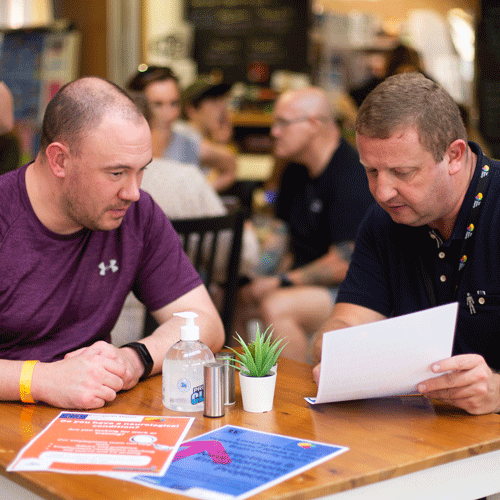The Sunflower is often used by organisations to develop their awareness of invisible disabilities for both their colleagues and customers and is a great catalyst to drive disability inclusion in the workplace. In this guest blog, Anna Quintal, The Brain Charity’s Employer Relationship Officer, looks at invisible disabilities in the workplace and how employers can make workplaces more inclusive.
How employers can make workplaces more invisible disability friendly

Anna Quintal is Employer Relationship Officer in The Brain Charity’s employment team. She builds relationships with employers across the Liverpool City Region to evaluate positions, match them to clients, offer advice on recruitment and advocate for the talent within the neurological community. Here, she shares how employers can make their workplaces more hidden disability-friendly.
At The Brain Charity, our employment team help people who face barriers to work due to their neurological condition find job, training and education opportunities.
Misconceptions around disabilities – particularly invisible – mean millions of people with neurological conditions are currently unemployed in the UK. Individuals with physical disabilities can be challenged by tangible barriers in the workplace – such as inaccessible physical spaces. But the situation can become even more complex for people with a disability we can’t see or immediately identify. Hidden disabilities can be physical, mental or neurological. They can be caused by fatigue, brain injury or debilitating pain. Dyslexia, autism, ADHD and Multiple Sclerosis are all examples of hidden disabilities.
Unfortunately, people can be all too quick to judge and misunderstand people if we can’t see evidence of somebody’s condition. Often, this is based on their own imagination or the normative experiences they’ve been dealt. Given that people are still largely categorised as ‘disabled’ or ‘able’ based on what is visible, this leads to distrust when individuals don’t ‘look’ disabled or act in the perceived way an ‘able’ person might expect. An individual with an autism diagnosis may face discrimination in the workplace or be considered ‘rude’ for avoiding eye contact and requiring headphones and a quiet space to work instead of a loud open plan office.
A person with a chronic fatigue diagnosis might face a disciplinary for taking extended breaks or longer period of absence, when a simple solution to their work life would be flexible hours, allowing for rest when required. This prejudice is damaging, not just to applicants with disabilities but to employers, who are missing out on some of the best, and most neurodiverse, talent. So what can we do to make workplaces more hidden disability-friendly?
Identify the barriers
As employers, it is our duty to identify barriers our employees may be facing in the workplace. Sometimes that requires some self-reflection, and asking questions of the whole team.
If your employees come up against barriers that they can’t break down through fear of discrimination, it may be there is a societal or attitudinal problem standing in the way of their success.
Examples of attitudinal barriers may include:
- Seeing disability as a personal tragedy, or assuming the individual is unhealthy and has poor quality of life. If a team holds this attitude, they may be unintentionally fuelling the belief that people with disabilities are not fit for the workplace. This attitude will only result in the anticipation of a ‘cure’ or change in behaviour that matches up with their own understanding of normal, before accepting a person can be successful with a disability.
- Paradoxically, the opinion that staff with disabilities are given an unfair advantage, a smaller workload or better treatment because of their disability is still very common and equally damaging in the workplace.
- A belief that adjustments for staff with disabilities will be expensive. Employers jump to assumptions that adjustments will be costly and time consuming, but in most cases, adjustments are communicated and finalised during one conversation. Requests that do come with an associated cost are typically covered by Access to Work grants, a government scheme which helps people with disabilities and health conditions stay in work and can fund things like office equipment, transport or a PA.


Information, communication and technology
Hidden disabilities can sometimes present themselves as learning disabilities. Therefore, staying mindful of the way you distribute information is important. Could the language you use be considered difficult to understand, and therefore simplified? Could verbal instruction be offered as an alternative? Are you able to modify the technology you’re using to support an assistive device such as screen-reading software? By learning about our employees’ learning styles and abilities we are engaging with them in the most crucial way.
Many organisations use just one method to recruit, most commonly accepting a CV or written application form. A person with dyslexia or ADHD is at a significant disadvantage under this current process. A simple alternative could be the acceptance of a video, verbal recording or graphic.
Providing the applicant can demonstrate they are meeting the eligibility criteria and are able to carry out the job in question or work with the employer to carve an appropriate role, the application format shouldn’t matter.
Encourage disclosure
There is no obligation to disclose disability at any stage during the recruitment process or during the induction. But without disclosure, an employer may not be able to put flexible working hours in place for an individual with chronic fatigue or refer an employee to a mental health partner when they are struggling with anxiety. Regular meetings with a trusted supervisor, holding “away days” or workshops to talk openly about working styles and working with the employee to make tangible adjustments will all build trust.
If confidence is holding you back from hiring a person with additional needs or if you’re currently concerned about the welfare of your current staff, educating yourself and your team with a local training provider is key.
The Brain Charity’s neurodiversity training helps organisations understand what neurodiversity is and how to support individuals who are neurodiverse or have hidden disabilities in the workplace.
Ultimately, it is everyone’s responsibility in the workplace to challenge barriers, stop the use of offensive or out-dated language, and avoid tokenism.
Once a workspace has become accepting and all staff show a willingness to listen and learn, invisible barriers will become fundamentally easier to recognise and breakdown.


